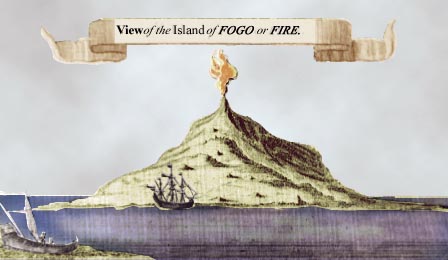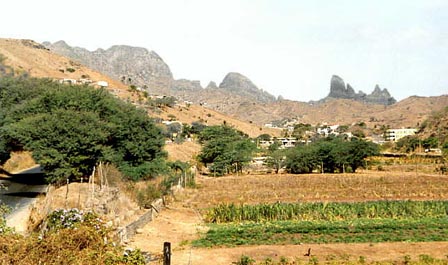Home Page
 | |
|
|
The Cape Verde Islands are located in the mid-Atlantic
Ocean some 450 kilomters (about 300 miles) off the west coast of Africa. The
archipelago includes ten islands and 5 islets, divided into the windward (Barlavento) and leeward (Sotavento) groups.
The main islands in the Barlavento group are:
Charles Darwin realized that the sand that covered many of the islands were carried from the Sahara Desert. He was able to figure out the direction of the winds by observing that: |  The volcano on Fogo burned almost continuously from 1500 AD to 1760 AD and served as a beacon to mariners.  Darwin explored St. Jago's inland area during his three-week stay in Cape Verde. |
We discussed how some ships that we might come across would not be as they seemed. Although slavery and slave-trading was outlawed in Cape Verde, slave ships often sailed in the area, as well as pirate ships. Both slave ships and pirate ships could easily disguise themselves as whaling ships.
For more information about pirates, please look at the following links:
- Read about
- Captain Henry Avery from the 17th century
- Captain Edward England
- Howell Davis from the early 18th century
- Bartholomew Roberts
- See the rules for those that served under him.
- See some of the flags that these pirates used.
- Skim a digest of newspaper reports on pirate plunderings between 1826-1831
- Learn some of the vocabulary of pirates
- An exhibit at the New Bedford Whaling Museum looks at
slave ships disguised as whale ships
-
Below is a letter from Frank Barrows of the US National Park Service about the
music of Cape Verde:
I do know that Cape Verdean music evolved as a blend of violins from Portugal, rhythms from Africa, and instruments such as "mazurkas" (spelling?) from Europe. The African side of the music was suppressed by the Portuguese and had to be hidden in many instances. On the island of Sao Tiago, Cape Verdeans would disguise the rhythm of their music in creative ways, such as grinding corn to the beat. You didn't necessarily have to have an instrument either, many Cape Verdeans would just drum on their body parts or any surface that would create a beat. I remember that my great uncle would always drum on his leg whenever he heard any kind of music. Since CV gained its independence in 1975, there has been a resurgence of African influenced CV music.
When I visited Cape Verde three years ago I met these four guys on the beach in Sao Vicente. One of them started rapping in Kriolu, then one by one, they would chime in to contribute. One of them picked up an empty milk carton on the beach and put it between his legs and started drumming, the next picked up a stick and an empty coke bottle and ran the stick along the ridges of the bottle to create a rhythm, then the fourth started singing background vocals. It was one of the most amazing things I've ever seen--totally improvised--and is sounded unbelievable--I wish I would have recorded it. But it illustrates the creativity and importance of music in Cape Verde. Music is also important in this country for Cape Verdeans because it's a link to the old country and a way to retain the Cape Verdean identity.
I hope this was helpful, let me know if I can help you in any other way.
Best,
Frank Barrows
New Bedford Whaling National Historical Park